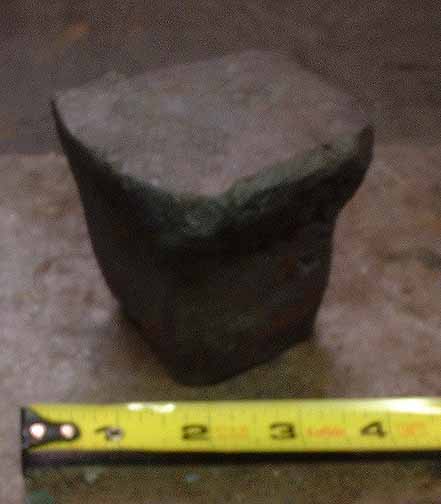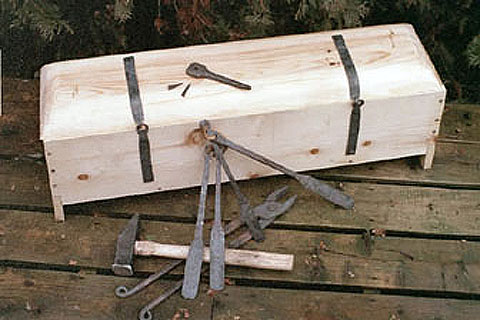I'm from england and I'm in a late roman reenactment group who are looking for a period forge to bring with them to shows. If you do happen to make forges for reenactment could you please come back to me, as it is extremely hard to find historical forges.There are a couple of problems here.
First, most of our early archaeological evidence seems to point to ground forges. I have seen some Greek illustrations (on ceramics) that show table styles, but I suspect before the Middle Ages proper, mostly the smith appears to have squatted or grabbed off the ground. There is a clear LACK of evidence, and as far as I know no examination of smith's bones has been made either.
That being the case, the general system is a side draft tuyere. Any charcoal forge will be side draft, typically with the air tube set about 7 - 10 cm above the base level of the fire box. This is to allow some place for the volumes of ash to collect, without choking off the air flow.
What you can expect is a low wall on one side, containing the tuyere. The easiest way to do this is just use clay to build up a crescent shape. Norse (later and more northern) has some artifacts which are bellows stones. Soapstone with a hole through it for the air blast.
There does not especially need to be a separate tuyere - if there is a heavy fire proof 'bellows side wall'. Such are common finds, and mainly made of ceramic. Again I have not looked specifically at Romano British. A substitute that also fits the archaeological record is a forged iron tube. As this working end of the air system is pretty much covered, for practicality simple steel pipe can be substituted. Note that 2 - 2.4 cm interior diameters do seem to be pretty standard to the artifact tubes. Because the bulk of the heat is directed to the bellows side wall, you might also be able to use hard wood or even antler / bone for the tube.
Many of the early systems have a version of double bag bellows, joined by a Y tube to the tuyere end. The easiest way to form this Y connector is to stitch one out of heavy leather. The use of leather also serves as a flexible coupling, reducing the jerking vibration from the bellows action to the more fragile tuyere / bellows wall side. This appears to have been an almost universal approach by almost everyone who has done any serious experimental archaeology with smelting, forging or casting.
The reason for the two bellows chambers is that the alternating blast cycle serves two important functions. First, this allows for a relatively constant air blast to be delivered. Second, because there is always some air being forced down the Y tube, you can effectively eliminate a downstream valve system. With a single chamber, without a downstream valve, any intake of air to the chamber will also draw hot gas from the forge back up into the bellows bag. (Double plus not good!)
The biggest cultural indicator may be the bellows. There are a number of types possible, which certainly appear to increase in relative complexity as history progresses. The biggest problem here is finding any artifact evidence. Typically, there is absolutely none surviving. Bellows are universally constructed from wood planks with leather bags - both materials which rarely survive. (The exception are ceramic 'pot' bellows, which is a system used in some parts of Africa.) Generally you have to look to period illustrations of blacksmiths at work for an indication of which system was used. (I would expect there would be regional variations on this as well.)
The simplest (and 'earliest') way to construct a bellows is to take a small animal body, cut it in half, then put a wooden plate across the larger open end. One leg then forms the supply tube to the tuyere. The wooden plate has a central hole, with a strap across it. In use, you hand goes through the strap. Lift you hand, you fill the leather bag. Push down, your palm seals across the hole, forcing the air down the leg tube.
A variation on this is to use a pair of sticks stitched along the open edges. You push the sticks together (closed) on the down stroke, slide them apart on the upwards, fill stroke. (I suspect there is a bit of a trick to this!)
Bronze casting furnace, by Umha Aois, in a 2008 demonstration.
Although this is a furnace (with a closed bowl) this clip clearly shows the bellows in action, the use of a leather Y tube.
A later variation on both those is the 'drum' bellows, which uses two cylindrical chambers, each with a simple leather flap valve in place of the operators palm. In theory (and eventually in practice) it is possible to make a very large cylinder, so deliver large air volumes.
Into Anglo-Saxon / Viking Age times, there is the development of a double 'accordion' system. Two escencially U shaped chambers siting side by side. This system appears to remain in use into the Medieval period, the chambers getting larger and larger (eventually water powered).
 A Norse forge with bellows stone, set up on a (speculative!) sand table forge
A Norse forge with bellows stone, set up on a (speculative!) sand table forgeDARC, presentation at Haffenreffer Museum in 2006
The other primarily indicator of date and cultural set is going to be the anvil.
Generally, early anvils are small and simple. Little more than cubes of iron, perhaps with one facet drawn off to a slight square taper, to allow better mounting in a wooden stump. It is unusual to find one with a horn. (A separate L shaped stake would serve that function - if one was used at all.) Surviving examples from the Viking Age are generally about 10 cm on a side. This will allow you to make most objects, remember the heat zone from that charcoal fire is rarely much more than this same 10 cm. Larger work would be roughed out on a block of stone.
 Replica Early Period anvil. Forged from bloomery iron, about 8 cm per side on the face.
Replica Early Period anvil. Forged from bloomery iron, about 8 cm per side on the face.Produced at Early Iron 3, with Lee Sauder and Mike McCarthy
The other tools of the blacksmith, hammers, tongs, punches, are ageless and universal.
So - to get back to your specific question, a Romano British forge:
- I would expect a simple ground forge, likely clay as the bellows side wall. This would be a 'build on site and discard' unit.
- Depending on just exactly what part of Roman Brittan you are interested in, the bellows is possibly a double drum or accordion style.
- Your anvil should be a small block style.






















No comments:
Post a Comment